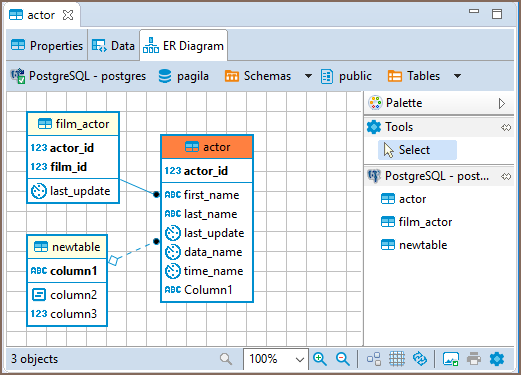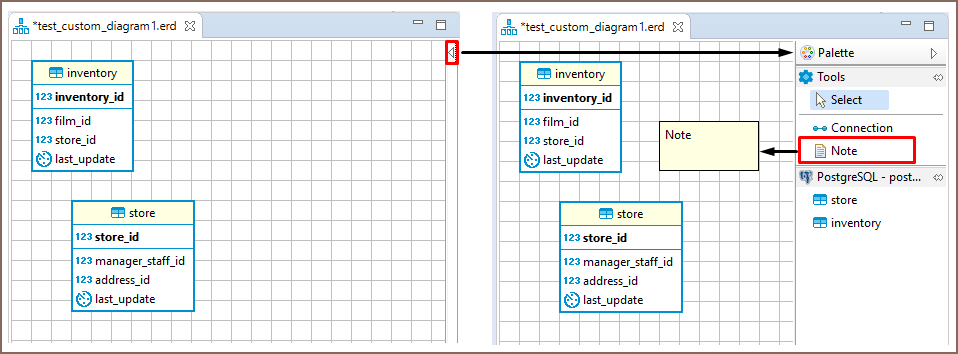How To Create Er Diagram In Dbeaver
ER Diagrams
ER diagrams appear on the rightmost tab of the Database Object Editor:

Entity Relation Diagrams (ERD) are graphic presentations of database entities and the relations between them. DBeaver allows you to view the diagrams of existing tables and whole database schemas, see Database Structure Diagrams. DB also allows the creation of custom diagrams, see Custom Diagrams.
By default DBeaver uses IDEF1X notation.
Both types of diagrams provide the same tools to adjust their view and structure. They can be printed and exported to image file formats.
Selection of Elements in Diagrams
You can use one of the two tools to select elements in diagrams:
-
Select – supports both, single and multi-select modes. To select a single element (table, connection, entity inside a table) in a diagram, just click that element. To select multiple elements, similar to using the Marquee tool, click outside the first element and draw until all elements you need are in focus:

Structure Adjustment
NOTE: All changes to existing database schemas cannot be saved and are intended for exploration purposes only.
You can do the following structural changes in the diagrams.
- Add new tables to a diagram by drag-n-dropping them onto the diagram field from the Database Navigator.
- Rearrange tables in the diagram by dragging them all over the space. You can select several tables and drag them to a new location.
- Auto-arrange tables into a compact view after manual rearrangements: click the Arrange Diagram (
 ) in the toolbar or on the context menu (right-click anywhere on the diagram tab).
) in the toolbar or on the context menu (right-click anywhere on the diagram tab). -
(Available for Custom Diagrams only) - connect tables with a connector: click the Show Palette button (
 ) in the upper-left corner of the diagram tab and then, in the Palette panel, click Connection:
) in the upper-left corner of the diagram tab and then, in the Palette panel, click Connection: Now click the tables that you want to connect with each other in turn, one by one. To stop the connection line, double-click the last table
Now click the tables that you want to connect with each other in turn, one by one. To stop the connection line, double-click the last table - (Available for Custom Diagrams only) - removes tables and connections: right-click the table or conection and click Delete on the context menu or just click the table or connection and press Delete.
View Adjustment
You can adjust the view of any diagram in the following ways:
Refresh
To see changes made by others to the database schema, you might need to refresh the diagram: click Refresh Diagram (![]() ) in the toolbar.
) in the toolbar.
Notes
You can create notes only in Custom Diagrams. To create a note, click the Show Palette button (![]() ) in the upper-left corner of the diagram tab. Then, in the Palette panel, click Note and click anywhere in the diagram tab. Now you can double-click the Note box to enter the note text:
) in the upper-left corner of the diagram tab. Then, in the Palette panel, click Note and click anywhere in the diagram tab. Now you can double-click the Note box to enter the note text:

Search in Diagram Entities
To search among entities of a diagram, click the Search items button (![]() ) in the toolbar, then type in the search combination. The entities that contain the search combination are highlighted in the diagram. To remove the filter, click the cross icon next to the search field.
) in the toolbar, then type in the search combination. The entities that contain the search combination are highlighted in the diagram. To remove the filter, click the cross icon next to the search field.
Diagram Export
You can export (save) a diagram as an image (PNG, GIF, BMP formats) or as a file in GraphML format. To export a diagram, click Save diagram in external format ( ) in the toolbar.
) in the toolbar.
Diagram Printing
To print a diagram, press CTRL+P or click Print Diagram (![]() ) on the toolbar.
) on the toolbar.
Settings
To modify the diagram settings, click Configuration (![]() ) on the toolbar.
) on the toolbar.
How To Create Er Diagram In Dbeaver
Source: https://dbeaver.com/docs/wiki/ER-Diagrams/
Posted by: jacksonsentin2001.blogspot.com

0 Response to "How To Create Er Diagram In Dbeaver"
Post a Comment